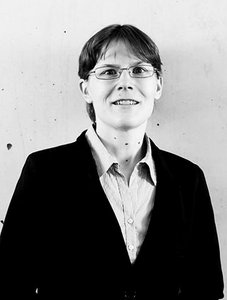Highlights
Publication Highlights
Superdiffusive Dispersals Impart the Geometry of Underlying Random Walks
V. Zaburdaev, I. Fouxon, S. Denisov, and E. Barkai, Phys. Rev. Lett. 117, 270601
It is recognized now that a variety of real-life phenomena ranging from diffusion of cold atoms to the motion of humans exhibit dispersal faster than normal diffusion. Lévy walks is a model that excelled in describing such superdiffusive behaviors albeit in one dimension. Here we show that, in contrast to standard random walks, the microscopic geometry of planar superdiffusive Lévy walks is imprinted in the asymptotic distribution of the walkers. The geometry of the underlying walk can be inferred from trajectories of the walkers by calculating the analogue of the Pearson coefficient.
weiterlesenIt is recognized now that a variety of real-life phenomena ranging from diffusion of cold atoms to the motion of humans exhibit dispersal faster than normal diffusion. Lévy walks is a model that excelled in describing such superdiffusive behaviors albeit in one dimension. Here we show that, in contrast to standard random walks, the microscopic geometry of planar superdiffusive Lévy walks is imprinted in the asymptotic distribution of the walkers. The geometry of the underlying walk can be inferred from trajectories of the walkers by calculating the analogue of the Pearson coefficient.
Institute's News
New research group 'Statistical Physics of Living Systems'
We are glad to announce the arrival of Dr. Steffen Rulands, who heads the research group 'Statistical Physics of Living Systems' since 1 January 2017. The group will investigate mechanisms of collective cellular decision making in tissue development, maintenance and disease.
weiterlesenAwards and Honors
"To the edge of life, and back again" - 1.3 Mio. Euro VW-grant for joint interdisciplinary proposal
Vasily Zaburdaev (MPI-PKS), Simon Alberti (MPI-CBG), Teymuras Kurzchalia (MPI-CBG) and Jochen Guck (BIOTEC, TU Dresden) receive a 1.3 million Euro grant from the Volkswagen Foundation (VolkswagenStiftung). The joint project focuses on the underlying biological, chemical, and physical mechanisms of cell dormancy.
weiterlesenPublication Highlights
Load Response of the Flagellar Beat
Gary S. Klindt, Christian Ruloff, Christian Wagner, and Benjamin M. Friedrich, Phys. Rev. Lett. 117, 258101 (2016)
Cilia and flagella exhibit regular bending waves that perform mechanical work on the surrounding fluid, to propel cellular swimmers and pump fluids inside organisms. Here, we quantify a force-velocity relationship of the beating flagellum, by exposing flagellated Chlamydomonas cells to controlled microfluidic flows. A simple theory of flagellar limit-cycle oscillations, calibrated by measurements in the absence of flow, reproduces this relationship quantitatively. We derive a link between the energy efficiency of the flagellar beat and its ability to synchronize to oscillatory flows.
weiterlesenCilia and flagella exhibit regular bending waves that perform mechanical work on the surrounding fluid, to propel cellular swimmers and pump fluids inside organisms. Here, we quantify a force-velocity relationship of the beating flagellum, by exposing flagellated Chlamydomonas cells to controlled microfluidic flows. A simple theory of flagellar limit-cycle oscillations, calibrated by measurements in the absence of flow, reproduces this relationship quantitatively. We derive a link between the energy efficiency of the flagellar beat and its ability to synchronize to oscillatory flows.
Awards and Honors
Frank Jülicher erhält den Gottfried Wilhelm Leibniz-Preis 2017
Frank Jülicher erhält den wichtigsten deutschen Forschungsförderpreis für seine herausragenden Beiträge zur theoretischen Biophysik.
Der Gottfried Wilhelm Leibniz Preis wird von der Deutschen Forschungsgemeinschaft verliehen und geht in diesem Jahr an 3 Wissenschaftlerinnen und 7 Wissenschaftler.
Der Leibniz-Preis ist mit 2.5 Millionen Euro Forschungsgeldern dotiert.
-->Pressemitteilung
weiterlesen-->Pressemitteilung
Publication Highlights
Fermionic response from fractionalization in an insulating two-dimensional magnet
J. Nasu, J. Knolle, D. L. Kovrizhin, Y. Motome and R. Moessner Nature Physics (2016)
Conventionally ordered magnets possess bosonic elementary excitations, called magnons. By contrast, no magnetic insulators in more than one dimension are known whose excitations are not bosons but fermions. Theoretically, some quantum spin liquids (QSLs)—new topological phases that can occur when quantum fluctuations preclude an ordered state—are known to exhibit Majorana fermions as quasiparticles arising from fractionalization of spins. Alas, despite much searching, their experimental observation remains elusive. Here, we show that fermionic excitations are remarkably directly evident in experimental Raman scattering data across a broad energy and temperature range in the two-dimensional material α-RuCl3. This shows the importance of magnetic materials as hosts of Majorana fermions. In turn, this first systematic evaluation of the dynamics of a QSL at finite temperature emphasizes the role of excited states for detecting such exotic properties associated with otherwise hard-to-identify topological QSLs.
weiterlesenConventionally ordered magnets possess bosonic elementary excitations, called magnons. By contrast, no magnetic insulators in more than one dimension are known whose excitations are not bosons but fermions. Theoretically, some quantum spin liquids (QSLs)—new topological phases that can occur when quantum fluctuations preclude an ordered state—are known to exhibit Majorana fermions as quasiparticles arising from fractionalization of spins. Alas, despite much searching, their experimental observation remains elusive. Here, we show that fermionic excitations are remarkably directly evident in experimental Raman scattering data across a broad energy and temperature range in the two-dimensional material α-RuCl3. This shows the importance of magnetic materials as hosts of Majorana fermions. In turn, this first systematic evaluation of the dynamics of a QSL at finite temperature emphasizes the role of excited states for detecting such exotic properties associated with otherwise hard-to-identify topological QSLs.
Publication Highlights
Phase Structure of Driven Quantum Systems
Vedika Khemani, Achilleas Lazarides, Roderich Moessner, and S.L. Sondhi Phys. Rev. Lett. 116, 250401 (2016)
Clean and interacting periodically driven systems are believed to exhibit a single, trivial “infinite-temperature” Floquet-ergodic phase. In contrast, here we show that their disordered Floquet many-body localized counterparts can exhibit distinct ordered phases delineated by sharp transitions. Some of these are analogs of equilibrium states with broken symmetries and topological order, while others—genuinely new to the Floquet problem—are characterized by order and nontrivial periodic dynamics. We illustrate these ideas in driven spin chains with Ising symmetry.
weiterlesenClean and interacting periodically driven systems are believed to exhibit a single, trivial “infinite-temperature” Floquet-ergodic phase. In contrast, here we show that their disordered Floquet many-body localized counterparts can exhibit distinct ordered phases delineated by sharp transitions. Some of these are analogs of equilibrium states with broken symmetries and topological order, while others—genuinely new to the Floquet problem—are characterized by order and nontrivial periodic dynamics. We illustrate these ideas in driven spin chains with Ising symmetry.
Publication Highlights
Similarity of Symbol Frequency Distributions with Heavy Tails
Martin Gerlach, Francesc Font-Clos, and Eduardo G. Altmann, Phys. Rev. X 6, 021009 (2016)
Quantifying the similarity between symbolic sequences is a traditional problem in information theory which requires comparing the frequencies of symbols in different sequences. In numerous modern applications, ranging from DNA over music to texts, the distribution of symbol frequencies is characterized by heavy-tailed distributions (e.g., Zipf’s law). The large number of low-frequency symbols in these distributions poses major difficulties to the estimation of the similarity between sequences; e.g., they hinder an accurate finite-size estimation of entropies. Here, we show analytically how the systematic (bias) and statistical (fluctuations) errors in these estimations depend on the sample size N and on the exponent γ of the heavy-tailed distribution. Our results are valid for the Shannon entropy (α=1), its corresponding similarity measures (e.g., the Jensen-Shanon divergence), and also for measures based on the generalized entropy of order α. For small α’s, including α=1, the errors decay slower than the 1/N decay observed in short-tailed distributions. For α larger than a critical value α*=1+1/γ <= 2, the 1/N decay is recovered. We show the practical significance of our results by quantifying the evolution of the English language over the last two centuries using a complete α spectrum of measures. We find that frequent words change more slowly than less frequent words and that α=2 provides the most robust measure to quantify language change.
See also coverage in Physics Today and Physics.
weiterlesenQuantifying the similarity between symbolic sequences is a traditional problem in information theory which requires comparing the frequencies of symbols in different sequences. In numerous modern applications, ranging from DNA over music to texts, the distribution of symbol frequencies is characterized by heavy-tailed distributions (e.g., Zipf’s law). The large number of low-frequency symbols in these distributions poses major difficulties to the estimation of the similarity between sequences; e.g., they hinder an accurate finite-size estimation of entropies. Here, we show analytically how the systematic (bias) and statistical (fluctuations) errors in these estimations depend on the sample size N and on the exponent γ of the heavy-tailed distribution. Our results are valid for the Shannon entropy (α=1), its corresponding similarity measures (e.g., the Jensen-Shanon divergence), and also for measures based on the generalized entropy of order α. For small α’s, including α=1, the errors decay slower than the 1/N decay observed in short-tailed distributions. For α larger than a critical value α*=1+1/γ <= 2, the 1/N decay is recovered. We show the practical significance of our results by quantifying the evolution of the English language over the last two centuries using a complete α spectrum of measures. We find that frequent words change more slowly than less frequent words and that α=2 provides the most robust measure to quantify language change.
See also coverage in Physics Today and Physics.
Publication Highlights
Proximate Kitaev quantum spin liquid behaviour in a honeycomb magnet
A. Banerjee, C. A. Bridges, J.-Q. Yan, A. A. Achel, L. Li, M. B. Stone, G. E. Granroth, M. D. Lumsden, Y. Yiu, J. Knolle, S. Bhattacharjee, D. L. Kovrizhin, R. Moessner, D. A. Tennant, D. G. Mandrus & S. E. Nagler, Nature Materials 15, 733 (2016)
Quantum spin liquids (QSLs) are topological states of matter exhibiting remarkable properties such as the capacity to protect quantum information from decoherence. Whereas their featureless ground states have precluded their straightforward experimental identification, excited states are more revealing and particularly interesting owing to the emergence of fundamentally new excitations such as Majorana fermions. Ideal probes of these excitations are inelastic neutron scattering experiments. These we report here for a ruthenium-based material, α-RuCl3, continuing a major search (so far concentrated on iridium materials) for realizations of the celebrated Kitaev honeycomb topological QSL. Our measurements confirm the requisite strong spin–orbit coupling and low-temperature magnetic order matching predictions proximate to the QSL. We find stacking faults, inherent to the highly two-dimensional nature of the material, resolve an outstanding puzzle. Crucially, dynamical response measurements above interlayer energy scales are naturally accounted for in terms of deconfinement physics expected for QSLs. Comparing these with recent dynamical calculations involving gauge flux excitations and Majorana fermions of the pure Kitaev model, we propose the excitation spectrum of α-RuCl3 as a prime candidate for fractionalized Kitaev physics.
weiterlesenQuantum spin liquids (QSLs) are topological states of matter exhibiting remarkable properties such as the capacity to protect quantum information from decoherence. Whereas their featureless ground states have precluded their straightforward experimental identification, excited states are more revealing and particularly interesting owing to the emergence of fundamentally new excitations such as Majorana fermions. Ideal probes of these excitations are inelastic neutron scattering experiments. These we report here for a ruthenium-based material, α-RuCl3, continuing a major search (so far concentrated on iridium materials) for realizations of the celebrated Kitaev honeycomb topological QSL. Our measurements confirm the requisite strong spin–orbit coupling and low-temperature magnetic order matching predictions proximate to the QSL. We find stacking faults, inherent to the highly two-dimensional nature of the material, resolve an outstanding puzzle. Crucially, dynamical response measurements above interlayer energy scales are naturally accounted for in terms of deconfinement physics expected for QSLs. Comparing these with recent dynamical calculations involving gauge flux excitations and Majorana fermions of the pure Kitaev model, we propose the excitation spectrum of α-RuCl3 as a prime candidate for fractionalized Kitaev physics.
Institute's News
New research group 'Quantum Many-Body Systems'
We are glad to announce the arrival of Dr. Anne Ersbak Bang Nielsen, who heads the Max Planck Research Group 'Quantum many-body systems' since 1 March 2016.
weiterlesen



